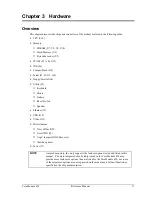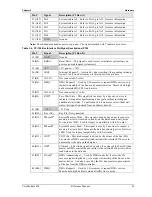
Chapter 3
Hardware
CoreModule 420
Reference Manual
31
Floppy/Parallel Port (J4)
Floppy Disk Drive Port
The Super I/O chip provides the Floppy Disk Controller and the Parallel Port interface (J4). The Floppy
Drive interface shares the same connector as the Parallel Port and the signals are multiplexed out of the
connector. However, you can only use one of these devices at a time and it must be configured in BIOS
Setup Utility. The default device in the BIOS Setup Utility is the Floppy Drive.
The Floppy Disk Controller supports two floppy disk drives from 360kB through 2.88MB and is
configured as the floppy interface in the BIOS.
NOTE
Due to the multiplexed nature of the signals for the floppy disk and parallel
connector, you can only connect one of these devices at a time. Refer to
Chapter 4, BIOS Setup
later in this manual when selecting the floppy or
parallel device in the BIOS Setup Utility.
Parallel Port
The Super I/O chip provides the Parallel Port interface and Floppy Disk Controller, which share the
same output connector (J4). The Parallel Port supports the standard parallel, Bi-directional, Standard
Printer Port (SPP), Enhanced Parallel Port (EPP), and Enhanced Capabilities Port (ECP) protocols.
Table 3-11. Parallel Interface (SPP) Pin/Signal Descriptions (J4)
Pin #
Signal
Description
1
Strobe*
Strobe* – This is an output signal used to strobe data into the printer. I/O pin
in ECP/EPP mode.
2
AutoFD*
DRVO
Auto Feed* – This is a request signal into the printer to automatically feed one
line after each line is printed.
Floppy Drive Density Select 0 – This signal indicates a low (250/300kbps) or
high (500kbps) data rate has been selected.
3
PD0
INDEX
Parallel Port Data 0 – This pin (0 to 7) provides parallel port data signals.
Index – Sense detects the head is positioned over the beginning of a track
4
ERR*
HDSEL
Error – This is a status output signal from the printer. A Low State indicates
an error condition on the printer.
Head Select – Selects the side for Read/Write operations (0 = side 1,
1 = side 0)
5
PD1
TRK0
Parallel Port Data 1 – This pin (0 to 7) provides parallel port data signals.
Track 0 – Indicates when the head is positioned over track 0 (outermost track).
6
INIT*
DIR
Initialize* – This signal is used to Initialize printer. Output in standard mode,
I/O in ECP/EPP mode.
Direction – This signal determines direction of head movement
(0 = inward motion, 1 = outward motion).
7
PD2
WRPRT
Parallel Port Data 2 – This pin (0 to 7) provides parallel port data signals.
Write Protect – Senses the diskette is write protected.
Summary of Contents for CoreModule 420
Page 1: ...CoreModule 420 PC 104 Single Board Computer Reference Manual P N 5001692A Revision A ...
Page 6: ...Contents vi Reference Manual CoreModule 420 ...
Page 10: ...Chapter 1 About this Manual 4 Reference Manual CoreModule 420 ...
Page 22: ...Chapter 2 Product Overview 16 Reference Manual CoreModule 420 ...
Page 50: ...Chapter 3 Hardware 44 Reference Manual CoreModule 420 ...
Page 64: ...Appendix A Technical Support 58 Reference Manual CoreModule 420 ...
Page 66: ...Appendix B Connector Part Numbers 60 Reference Manual CoreModule 420 ...
Page 70: ...Index 64 Reference Manual CoreModule 420 ...
Page 71: ......
Page 72: ......














































